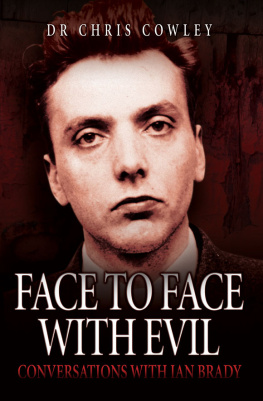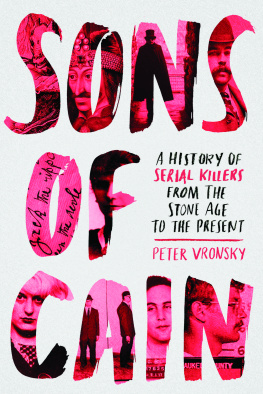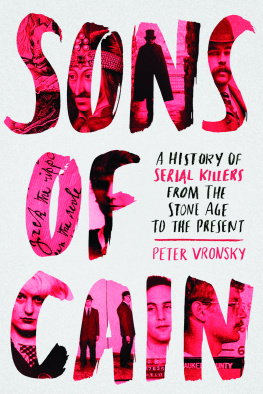
This edition published in 2012 by Arcturus Publishing Limited
26/27 Bickels Yard, 151153 Bermondsey Street, London SE1 3HA
Copyright 2012 Arcturus Publishing Limited
All rights reserved. No part of this publication may be reproduced, stored in a retrieval system, or transmitted, in any form or by any means, electronic, mechanical, photocopying, recording or otherwise, without prior written permission in accordance with the provisions of the Copyright Act 1956 (as amended). Any person or persons who do any unauthorised act in relation to this publication may be liable to criminal prosecution and civil claims for damages.
Picture Credits
Images courtesy of AP, Corbis, Getty, Rex and Topfoto. For more information contact info@arcturuspublishing.com.
ISBN: 978-1-84858-956-8
AD002432EN
Contents
Introduction
For most of us, the crazed mind of the serial killer is a closed book, one that we may be curious to open, perhaps, but one that we know will fill us with terror. What do we expect to find there? Unimagined horrors, unspeakable desires, inexplicable compulsions and inhuman cruelty at best. At worst, we may encounter some stirrings of recognition in ourselves, some acknowledgement of our own curiosity about death and dying. However much we may deny it, we are fascinated by what serial killers do, how they do it and why they do it. We want to know about the different ways in which the human body can be destroyed, dismembered and ritually abused; about how victims suffer; about the links between sex, pain, torture and death. Most of all, perhaps, we want to know about the psychology of the serial killer, the individual who acts upon the darkest of human impulses and lets them surface into reality.
The Lone Killer
Mass murderers have existed since the beginning of recorded history. In some eras, they were kings, queens and princes: think of Vlad the Impaler, Catherine the Great or the mad Ottoman ruler Murad IV. Hideously cruel methods of torture and killing that we now consider completely inhuman were part of everyday life in many ages and civilizations, from the Aztecs and the Barbarians to early Polynesian cultures and medieval Europe. In modern times, state-sanctioned atrocities on a grand scale have been committed, for example in Nazi Germany and, more recently, in Rwanda. However, the phenomenon of the serial killer, who generally works alone and in secret, usually killing victims one at a time, is a different one. These are the murderers that we find particularly disturbing, the ordinary people who could be our next-door neighbours or office co-workers, the individuals who may have a troubled family history but who, on the face of it, have no more reason to kill than the rest of us. These are the murderers who baffle and terrify us, precisely because they seem so ordinary and so much on the surface just like us. However, when they are finally caught they are revealed to have tortured and killed a string of innocent victims, often in the most gruesome ways imaginable.
The Ordinary Killer
Our list of serial killers contains many apparently ordinary people. Ted Bundy, for example, was an attractive, self-confident man who escaped the law for many years precisely because he seemed so unlike the accepted image of a lonely, psychotic killer. Nevertheless, Bundy killed scores of young women and girls, the youngest aged twelve. Before clubbing his victims to death, he raped them and bit their bodies ferociously, often leaving marks all over them. (It was the bite marks that finally led to his conviction, when an impression from his teeth matched the marks on the bodies.) Meanwhile in Britain, ex-policeman Dennis Nilsen, a closet homosexual, murdered a string of men he brought home, storing body parts in his home in a bizarre way that was later described by his biographer Brian Masters as killing for company. His victims were mostly young drifters, one of them a skinhead with cut here tattooed on his neck an instruction Nilsen unfortunately took literally. It was only when his flat started to get crowded, and Nilsen took to boiling the body parts and flushing them down the toilet thus blocking the drains that he was finally caught.
In the same way, it was only when police visited the home of serial killer John Wayne Gacy and smelled the awful stench coming from the crawl space under his house that his ghastly spate of horrific murders was uncovered. Like Bundy and Nilsen, Gacy blended in well with his surroundings, seldom giving any indication of the horrors of his personal life. Gacy was a well-respected building contractor who lived in a middle-class neighbourhood and was active in politics, performing as a clown at childrens parties and charity events. Unbeknown to his neighbours, however, he had for years been luring boys as young as nine to his house, sodomizing them, torturing them on a homemade rack and finally garrotting them before dumping their bodies outside. In a chilling finale to his murderous career, when he was on death row he continued to function as an enterprising businessman, selling his paintings of skulls and clowns, which became collectors items and reached high prices.
Historical Figures
In the past, of course, many serial killers had no need to hide behind the faade of a conventional way of life. Historical figures such as the sixteenth-century Hungarian countess Erzebet Bathory were in a position to do what they liked; in Erzebets case what she liked was torturing servant girls to death. She would pierce them with pins, needles and branding irons, burn their vaginas with lighted candles and then attack them in a frenzy, tearing their breasts to pieces. During the torture sessions, she would also bite chunks of flesh from the girls. One victim was forced to cook and eat her own flesh. After these orgiastic rituals of torture and murder, the bodies of the girls would be left to rot, or dumped outside the castle walls for wolves to eat. This continued for years, without anyone intervening. It was only when Erzebet started to torture daughters of the nobility instead of mere peasant girls that the king decided to put a stop to her activities and ordered a night raid on the castle, catching her in the act. Even then, instead of being executed like her servant accomplices, Erzebet was given a special dispensation and, despite the fact that she had killed hundreds of victims, ended her days imprisoned in her castle rooms.
Anonymous Killers
Perhaps even more terrifying than these monsters of depravity, whether historical or modern day, are the ones who got away. The most infamous of these is, of course, Jack the Ripper. The fact that his victims were so brutally murdered, that he apparently issued taunting messages to the police and that his identity to this day remains unknown, continues to make this one of the most disturbing, and fascinating, cases of all time.
Jack the Ripper claimed his first victim in 1888 a prostitute in Londons East End known as Polly, though her real name was Mary Nichols. Her throat had been cut and there were vicious stab wounds to her stomach and genitals. About a month later, prostitute Annie Chapman was found disembowelled, her entrails laid across one shoulder. In a pattern that was to prove horribly familiar, parts of the body, in this case the bladder, vagina, womb and ovaries, were missing. The murders continued, each one more gruesome than the last; in the case of victim Catherine Eddowes, a kidney was removed and then half of it sent to the police with a letter bragging that the killer had eaten the other half. Finally, with the murder of Mary Kelly, the Ripper reached new depths of violence and madness: her dead body was disembowelled and her hand had been inserted into her stomach. In addition, her liver had been placed on her thigh, while her breasts had been cut off and laid out beside her severed heart, kidneys and nose. Strips of flesh were hung from nails around the room in which she was murdered. A post-mortem discovered that Kelly had been three months pregnant, but the Ripper had taken her womb and foetus with him.
Next page




![Charlotte Greig - Evil Serial Killers. In the Minds of Monsters [Fully Illustrated]](/uploads/posts/book/70143/thumbs/charlotte-greig-evil-serial-killers-in-the-minds.jpg)











